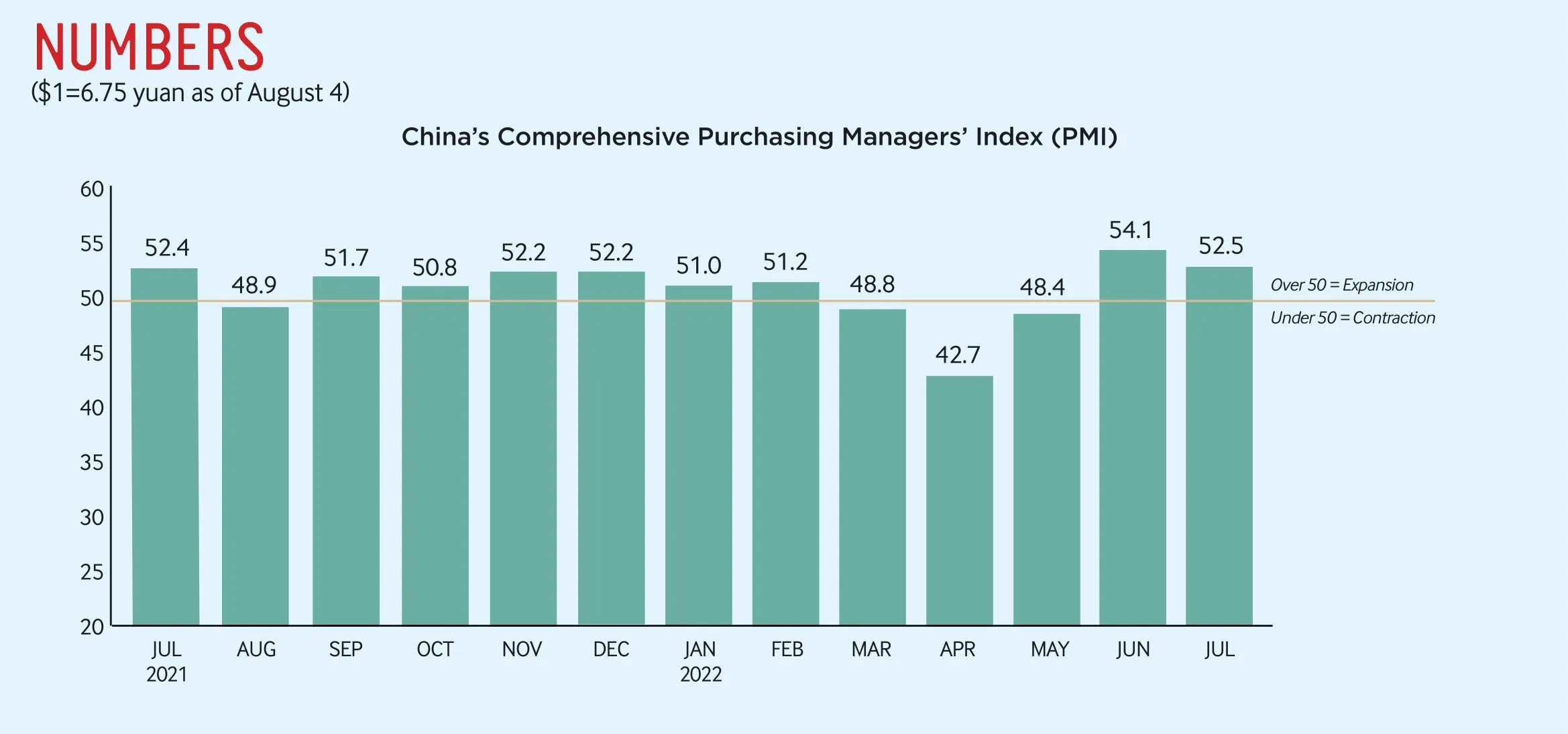THIS WEEK
2022-08-09
DIVING RIGHT IN

Tourists transplant corals on the seabed in Lingshui Li Autonomous County in Hainan Province on August 3. A diving festival recently kicked off in the county, attracting tourists to experience diving and coral transplantation.
New Growth Drivers

A new-energy vehicle components factory goes into operation in Shaoxing, Zhejiang Province, on August 2.The city has introduced integrated circuit and biomedicine industries in recent years to inject new impetus into its development.on August 3.
In 2021, Guizhou’s gross domestic product neared 2 trillion yuan ($295 billion), and the percapita disposable incomes of urban and rural residents in the province were 2.1 times and 2.7 times those in 2012, respectively.
Over the past 10 years, 9.23 million impoverished residents in Guizhou shook off poverty and achievements have been made in infrastructure development.
The digital economy also gained momentum in the province, with a focus on building the national big data comprehensive pilot zone and the digital economy development innovation zone.
Guizhou is also committed to prioritizing ecology and green development and its forest coverage rate exceeds 62 percent.
Soliciting Cultural Relics
Road Chiefs
China has established an extensive network of road chiefs across the country to manage roads in rural areas, Xinhua News Agency reported on August 2.
By the end of June, the country had 641,000 of these chiefs, i.e., people in counties,townships and villages who are in charge of the maintenance and management of local rural roads, according to the Ministry of Transport (MOT).
The road chief scheme covers 95.2 percent of county-level governments tasked with managing rural roads. China has also introduced similar programs,such as river chiefs, to strengthen policy implementation.
Rural infrastructure development, especially building roads,has played an important role in revitalizing rural areas.
MOT data showed that the combined length of rural roads had increased more than 900,000 km from 2011 to exceed 4.46 million km by the end of 2021.
National Archives
The China National Archives of Publications and Culture branch in Hangzhou, capital of Zhejiang Province, is open to visitors from August 1.
The Hangzhou branch is dedicated to chinoiserie and China’s traditional culture. It is adjacent to the ruins of Liangzhu Ancient City, a UNESCO World Heritage site.
Its venue integrates a library,museum, art gallery, archives and exhibition, the core functions of which are collection, exhibition, research and education.
The branch features four themed exhibitions and one digital exhibition. These will display collections showcasing social development achievements and cultural research projects in Zhejiang, as well as the stories and thoughts of the province’s prominent historical figures.
The China National Archives of Publications and Culture,headquartered in Beijing, opened on July 30. It has three branches,respectively in the cities of Xi’an in Shaanxi Province, Hangzhou,and Guangzhou in Guangdong Province.
Guizhou’s Progress
Guizhou Province has made significant progress in economic development and poverty alleviation over the past decade,according to a press briefing in the provincial capital of Guiyang The Capital Museum in Beijing has started a worldwide solicitation of cultural relics to present traditional Chinese culture,Xinhua reported on July 31.The museum is looking for exhibits including relics of the Grand Canal, a vast waterway connecting the northern and southern parts of China with a history of about 2,500 years,as well as relics related to the capital and its development, said Feng Hao, head of the collection department of the Capital Museum.
Feng added that a wide range of exhibits, including cultural relics, physical evidence,specimens, publications and replicas, will take center stage.“To encourage donations,the Capital Museum has further improved donors’ rights and interests. Donors [including individuals and institutions] will receive certificates of recognition,permanent records, and many other honors and rights,” Feng said.
Qi Miyun, Deputy Curator of the museum, said the museum is building its branch in Beijing’s Tongzhou District. The project is expected to complete by the end of 2022, and exhibitions will open to the public in 2023.
Wildlife Trade Crackdown
A campaign combating illegal wildlife trade investigated nearly 12,000 wildlife cases and seized more than 130,000 animals and plants from February 15 to May 15, the National Forestry and Grassland Administration said on August 2.
The campaign, which was launched by the administration and 10 other authorities, busted 719 criminal gangs and dealt with more than 14,000 criminals during the period.
The campaign also confiscated over 56 million yuan($8.3 million) of illegal gains and imposed fines and penalties worth more than 100 million yuan ($15.6 million).
Next, China will further improve its law enforcement mechanism and continue to carry out publicity and education activities to help crack down on illegal wildlife trade, the administration said.
Sci-Tech Services
China will launch a national campaign to better mobilize the science and technology sector to contribute to the country’s rural revitalization drive, according to a new set of guidelines, Xinhua reported on August 2.
Jointly issued by the China Association for Science and Technology and the National Rural Revitalization Administration, the guidelines specify a series of key tasks,including providing sci-tech training, lectures and industryspecific guidance to rural areas.
Sci-tech associations at all levels are called on to lead grassroots sci-tech workers to join in the work of rural revitalization.
The guidelines also require the relevant authorities to incorporate the construction of science popularization facilities into the overall layout of rural infrastructure and build more scitech museums in rural secondary schools.
Vegetation Coverage
China is becoming greener, with a steady increase in its vegetation coverage from 2000 to 2021, according to an official blue paper released on August 3.
During this period, China’s normalized difference vegetation index (NDVI), a key indicator of green coverage, reported a steady increase, stated the Blue Book on Climate Change in China (2022) issued by the China Meteorological Administration.Compared with the average level from 2001 to 2020, the NDVI rose 7.9 percent in 2021,marking the best performance of vegetation coverage since 2000,according to the report.
It noted that the average annual precipitation in China also showed an increasing trend.
From 1961 to 2021, the average annual precipitation in China registered an average increase of 5.5 mm every 10 years.
Coal to Culture

Tourists read at a bookstore in Da’nanpo Village in Jiaozuo, Henan Province, on July 30. The village once thrived on coal industry. In recent years, its old buildings have been transformed into bookstores,tea houses, exhibition centers and homestays, lifting the living environment of villagers and attracting tourists.
In Season

A worker showcases newly picked raspberries in Changqing,a village in Ningxia Hui Autonomous Region, on August 2.The village has been developing raspberry growing since 2017 to increase farmer incomes.
China-Europe Trains
The number of China-Europe freight train trips surged 11 percent year on year to a record 1,517 in July, according to China State Railway Group Co. Ltd. on August 2.
The trains handled 149,000 twenty-foot equivalent units of goods, up 12 percent from a year ago.
During the first seven months of the year, the number of China-Europe freight train trips rose 3 percent year on year to 8,990.The trains transported a total of 869,000 twenty-foot equivalent units of goods, an increase of 4 percent from a year ago.
Finance Companies
Foreign multinational groups will be able to establish finance companies directly or through foreign-funded investment companies established in China,according to a draft document released by the China Banking and Insurance Regulatory Commission on July 29.In the draft, the same market access conditions are applied to foreign-funded finance companies and their Chinese counterparts.
The document, which is now open to the public for feedback,has made provision updates in fields like market access requirements and business regulation.
The financial threshold for setting up a finance company has been raised in line with China’s economic status, with higher asset, revenue, profit and paid-in capital requirements for candidate corporate groups, it said.
Transition Goals
By 2025, the energy consumption per unit of the added value of industrial enterprises with an annual business turnover of at least 20 million yuan($2.96 million) will decrease 13.5 percent compared with 2020,according to a plan released by the country’s Ministry of Industry and Information Technology,National Development and Reform Commission and Ministry of Ecology and Environment on August 1.Efforts will be made to promote the optimization and upgrading of industrial structures, curb the development of low-level projects with high energy consumption and high emissions, and develop green and low-carbon industries, the plan noted.
By 2030, the proportion of vehicles powered by new energy and clean energy will reach about 40 percent of total new vehicles, and the carbon dioxide emission intensity of passenger cars and commercial vehicles will decrease 25 percent and 20 percent, respectively, compared with 2020.
Digital technologies will be further leveraged to empower the green and low-carbon transformation of the industrial sector,with a faster pace in the application and promotion of digital low-carbon solutions.
Business Expansion
Foreign-funded companies in China remain upbeat about the country’s development prospects and market potential, with the vast majority maintaining or expanding their business scale in the second quarter, according to a recent survey.
About 72.5 percent of the 500-plus surveyed enterprises maintained their business scale in the second quarter of the year,up 1.5 percentage points over the survey result in the January-March period, according to the report released by the China Council for the Promotion of International Trade.
Some 18.5 percent saw business expansion in China, marking an increase of 2.1 percentage points over the result of the previous survey.

It also showed 11.2 percent reported increased investment in the world’s second largest economy in the April-June period.
Over 40 percent of the surveyed companies said they would choose Chengdu and Chongqing in southwest China as the main destinations for investment, the report showed.
International Expo
The Second China International Consumer Products Expo (CICPE)concluded in Haikou, capital of Hainan Province, on July 30.
Exhibitors from 61 countries and regions attended the six-day expo. Some 2,800 brands from 1,955 enterprises, both domestic and international, participated in the exhibitions.
The event released over 600 new products. Shows featuring over 200 yachts of 50 wellknown brands were also held alongside the expo, according to the organizer.
Thirty-one companies from the sectors of fashion, travel services, and jewelry, to name a few, have signed up for the Third CICPE.
Green Loans
China’s green loans maintained fast expansion from the end of June 2021 to the end of June 2022 as the country steps up green growth efforts, a central bank report showed on July 29.
Outstanding green loans in yuan and foreign currencies reached 19.55 trillion yuan ($2.9 trillion) by the end of June,jumping 40.4 percent from the previous year, according to the People’s Bank of China.
A green loan refers to a form of financing where funds go to areas such as energy conservation and clean energy that make contributions to environmental protection and improvement.
Specifically, green loans for projects with direct or indirect carbon reduction benefits stood at 8 trillion yuan ($1.25 trillion)and 4.93 trillion yuan ($771 billion), respectively. Together,they accounted for 66.2 percent of the total green loans, the report showed.
ln the first half of 2022, the country saw its outstanding green loans increase by 3.53 trillion yuan ($552 billion).
China has advanced rapidly in developing its green financial system and markets, as part of efforts to achieve its carbon peaking and neutrality goals.
New Legislation
China’s law on futures and derivatives took effect on August 1.The law, the first of its kind in the country since futures and derivatives trading commenced about three decades ago, was approved at a session of the Standing Committee of the National People’s Congress in April. It is expected to help build a more regulated and open capital market and serve the sustained development of the real economy.
According to the China Futures Association, the country’s futures trading volume topped a record 7.5 billion lots last year.Total trading value also hit a historical high of 581.2 trillion yuan ($86 trillion) in 2021.
Telecom Capacity
The total length of fiber optic cables in China reached 57.9 million km at the end of June,an increase of 3.03 million km from the end of 2021, data from the Ministry of Industry and Information Technology showed.
The number of mobile phone base stations stood at 10.35 million, up 390,000 from the end of last year.
The country had 1.03 billion units of Internet broadband access ports as of late June, up 16.85 million units from late 2021.



NEW SPORT ADMINISTRATOR

Gao Zhidan has been promoted to head the General Administration of Sport of China(GASC).
Born in Siping, Jilin Province, in 1963, Gao graduated from the Beijing Sport University at the age of 25. He has spent his career at the GASC, including heading the department in charge of the country’s shooting and archery disciplines. In 2016, he became the GASC’s deputy director, and served in that capacity right up to his recent promotion. As deputy director, Gao was responsible for competition affairs, international cooperation and the daily undertakings of the Chinese Olympic Committee.
Gao has also overseen the country’s winter sports development.China grabbed nine gold medals and 15 overall at the Olympic Winter Games Beijing 2022, both record highs for a single Olympic Winter event.
In recent years, excursions, particularly countryside visits, have become the first choice for city dwellers looking for relaxation.During holidays, homestay bookings tend to skyrocket. Homestays have become a key feature of countryside tourism, contributing greatly to villagers’ incomes.
In some areas, villages have developed ways of operating such businesses based on local natural and cultural resources and becoming known for their specialties. In other places, however, the further development of this industry is plagued by problems like limited scope to grow, a lack of local attractions,poor quality and underdeveloped supportive facilities.
On the whole, country homestays have a broad market and are now in a prime period of growth. Rapid and healthy development requires guidance from the government and market-oriented adjustments. As part of local economies, homestay businesses may not be sustainable without the revitalization of the rural areas in which they operate. It’s important to incorporate their growth into the overall planning of rural development. In return,booming businesses will lift rural economies to higher levels.
“It requires all parties to listen,compromise and keep the lessons of the past—and the fragility of the future—in view at all times.”
António Guterres, UN Secretary General,at the 10th Nuclear Non-Proliferation Review Conference on August 1
“We must not let the Ukraine crisis kick off a new cold war. We must not repeat the mistakes of history. We must not let humanity experience once again the unbearable scourge of war.”
Geng Shuang, China’s Deputy Permanent Representative to the UN, at a Security Council briefing on July 29

Bucking the trend, the Chinese economy has registered positive growth despite the pressures of shrinking demand, shocks to supply and declining expectations. In the second quarter, its GDP rose by 0.4 percent over the same period of last year, and the rate for the first half of this year is 2.5 percent. The economy has stabilized and begun to bounce back, suggesting that recent policies for this purpose are working well,as they have coordinated the need to respond o possible COVID-19 resurgences and overall social and economic development.
Despite this upbeat momentum, a lot remains to be done in the second half of this year o bring the Chinese economy back on track.
Specifically, infrastructure investment—part of fixed assets investment—is performing well, countering the downward pressures on he economy. China is embracing another strong cycle of infrastructure investment, and employment is also improving. As more progrowth policies take effect, an increasing number of job opportunities will be created in he coming months.
Currently, policies to give businesses a ittle nudge focus on fee cuts and tax rebates.However, some small and micro enterprises feel they have benefited little, and therefore supportive policies must be more accurately crafted and effectively implemented.
By tapping into public welfare funds raised from lotteries, Jiangsu Province in east China has allocated 13 million yuan($1.92 million) to run summer classes.These classes are designed to look after children whose parents are unable to take care of them in the daytime during the summer vacation, mainly those of working parents. Some 31,000 children are benefiting from this service.
These summer classes have helped relieve working parents of a pressing concern:Children left alone may be exposed to danger.Accidents can only be avoided by the provision of proper supervision. Now, when they have places to study and play during the long holiday, their safety is ensured and they are also given quality lessons. This project will do them a lot of good during their childhood and perhaps even have a long-term impact on their life.
CELEBRATED PHYSICIST DIES AGED 101
Zhang Xingqian, an academician with the Chinese Academy of Sciences, passed away at the age of 101 in Beijing on July 29.
Zhang dedicated his career to the development of nuclear materials and explosion physics, and played an important role in securing valuable experimental data for nuclear device design and production.
Born in Wuyi, Hebei Province, Zhang graduated from Wuhan University in 1942 and received his Ph.D. in physical metallurgy from the Massachusetts Institute of Technology,the U.S., in 1952.
In 1955, Zhang returned to China and served as a professor of metal physics at a college now known as the University of Science and Technology Beijing. Later, he worked as an engineer at several research institutes and government departments.
He was a recipient of the National Science Prize and the National Award for Science and Technology Progress.

“No child should be born with or grow up with HIV, and no child with HIV should go without treatment.”
Tedros Adhanom Ghebreyesus, World Health Organization Director General, at the 24th International AIDS Conference on August 1
“The most miserable life is not being occupied by endless work but idling the days away.”
Zhang Junli, a self-taught painter in Taiyuan,Shanxi Province, who lost most of her joint functions as a child due to illness, in a recent interview with Xinhua News Agency
